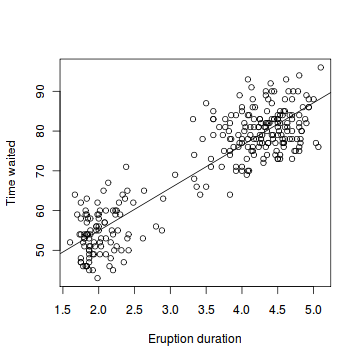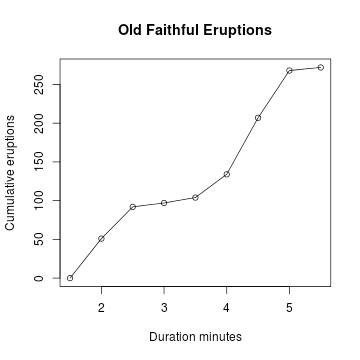Refer to
数据分析和统计, 首先数据有两种,
Qualitative Data (质性数据), also known as categorical, if its values belong to a collection of known defined non-overlapping classes. 就是离散数据.
Quantitative Data (数量型数据), 就是连续数据.
对于不同的数据, 统计的方法和表现的形式都是不同的, 所以分别介绍一下, 这是统计学的最基础的部分.
Qualitative Data
A data sample is called qualitative, also known as categorical, if its values belong to a collection of known defined non-overlapping classes. Common examples include student letter grade (A, B, C, D or F), commercial bond rating (AAA, AAB, ...) and consumer clothing shoe sizes (1, 2, 3, ...).Frequency Distribution of Qualitative Data, 频率分布
The frequency distribution of a data variable is a summary of the data occurrence in a collection of non-overlapping categories.
对于离散数据, 最直接的就是算frequency
> library(MASS) # load the MASS package
> school = painters$School # the painter schools > school.freq = table(school) # apply the table function> school.freq
school A B C D E F G H 10 6 6 10 7 4 7 4
Relative Frequency Distribution of Qualitative Data, 相对频率分布
The relative frequency distribution of a data variable is a summary of the frequency proportion in a collection of non-overlapping categories.
The relationship of frequency and relative frequency is:

> school.relfreq = school.freq / nrow(painters)
> school.relfreq
school A B C D E F G H 0.185185 0.111111 0.111111 0.185185 0.129630 0.074074 0.129630 0.074074
> old = options(digits=1) #print with fewer digits and make it more readable by setting the digits option
> cbind(school.relfreq) #cbind function to print the result in column format
school.relfreq A 0.19 B 0.11 C 0.11 D 0.19 E 0.13 F 0.07 G 0.13 H 0.07 > options(old) # restore the old option
Bar Graph, 柱状图
A bar graph of a qualitative data sample consists of vertical parallel bars that shows the frequency distribution graphically.
> colors = c("red", "yellow", "green", "violet", "orange", "blue", "pink", "cyan")
> barplot(school.freq, # apply the barplot function + col=colors) # set the color palette
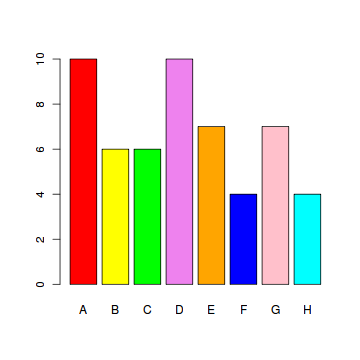
Pie Chart, 饼图
A pie chart of a qualitative data sample consists of pizza wedges that shows the frequency distribution graphically.
> pie(school.freq) # apply the pie function, 使用默认的颜色
Category Statistics, 按类别分析
对于离散数据, 最常用的就是按类别分析, 比如分析中国各省的评价收入水平, 分析各个年龄层的健康状况
R对此有非常好的支持, 因为对于Dataframe, index实在太灵活了, 很容易生成满足条件的子dataframe
Find the child data set of painters for school C.
> c_school = school == "C"
> c_painters = painters[c_school, ] # child data set
Find the mean composition score of school C.
> mean(c_painters$Composition)
[1] 13.167
Instead of computing the mean composition score manually for each school, use the tapply function to compute them all at once.
> tapply(painters$Composition, painters$School, mean)
A B C D E F G H 10.400 12.167 13.167 9.100 13.571 7.250 13.857 14.000
Quantitative Data
Quantitative data, also known as continuous data, consists of numeric data that support arithmetic operations.Frequency Distribution of Quantitative Data, 频率分布
The frequency distribution of a data variable is a summary of the data occurrence in a collection of non-overlapping categories.
连续数据怎么分析了, 简单的思路就是离散化, 分区间, 这样就可以和离散数据一样分析了
> duration = faithful$eruptions
> range(duration) [1] 1.6 5.1> breaks = seq(1.5, 5.5, by=0.5) # half-integer sequence
> breaks [1] 1.5 2.0 2.5 3.0 3.5 4.0 4.5 5.0 5.5> duration.cut = cut(duration, breaks, right=FALSE) #离散化
> duration.freq = table(duration.cut)
> duration.freq
duration.cut [1.5,2) [2,2.5) [2.5,3) [3,3.5) [3.5,4) [4,4.5) [4.5,5) [5,5.5) 51 41 5 7 30 73 61 4
Histogram, 直方图
A histogram consists of parallel vertical bars that graphically shows the frequency distribution of a quantitative variable. The area of each bar is equal to the frequency of items found in each class.
> duration = faithful$eruptions
> colors = c("red", "yellow", "green", "violet", "orange",
+ "blue", "pink", "cyan") > hist(duration, # apply the hist function + right=FALSE, # intervals closed on the left + col=colors, # set the color palette + main="Old Faithful Eruptions", # the main title + xlab="Duration minutes") # x-axis label
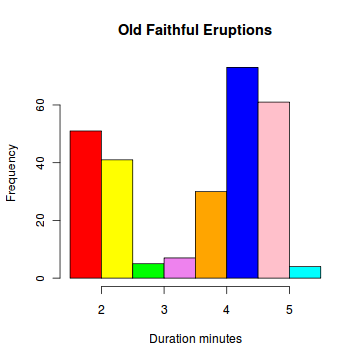
Relative Frequency Distribution of Quantitative Data
The relative frequency distribution of a data variable is a summary of the frequency proportion in a collection of non-overlapping categories.
The relationship of frequency and relative frequency is:

> duration.relfreq = duration.freq / nrow(faithful)
> old = options(digits=1)
> duration.relfreq duration.cut [1.5,2) [2,2.5) [2.5,3) [3,3.5) [3.5,4) [4,4.5) [4.5,5) [5,5.5) 0.19 0.15 0.02 0.03 0.11 0.27 0.22 0.01 > options(old) # restore the old option
Cumulative Frequency Distribution, 累积频数分布
The cumulative frequency distribution of a quantitative variable is a summary of data frequency below a given level.
> duration.cumfreq = cumsum(duration.freq)
> duration.cumfreq
[1.5,2) [2,2.5) [2.5,3) [3,3.5) [3.5,4) [4,4.5) [4.5,5) 51 92 97 104 134 207 268 [5,5.5) 272
Cumulative Frequency Graph, 累积频数图
A cumulative frequency graph or ogive of a quantitative variable is a curve graphically showing the cumulative frequency distribution.
> cumfreq0 = c(0, cumsum(duration.freq)) #Y轴要加上一个0
> plot(breaks, cumfreq0, # plot the data, 分别事x轴, y轴 + main="Old Faithful Eruptions", # main title + xlab="Duration minutes", # x-axis label + ylab="Cumumlative Eruptions") # y-axis label > lines(breaks, cumfreq0) # join the points, 画条线
Cumulative Relative Frequency Distribution
The cumulative relative frequency distribution of a quantitative variable is a summary of frequency proportion below a given level.
The relationship between cumulative frequency and relative cumulative frequency is:

Cumulative Relative Frequency Graph
A cumulative relative frequency graph of a quantitative variable is a curve graphically showing the cumulative relative frequency distribution.
还能这样画,
> Fn = ecdf(duration) # compute the interplolate
> plot(Fn, # plot Fn + main="Old Faithful Eruptions", # main title + xlab="Duration minutes", # x−axis label + ylab="Cumumlative Proportion") # y−axis label
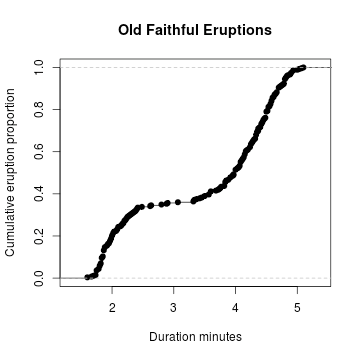
Stem-and-Leaf Plot, 茎叶图
A stem-and-leaf plot of a quantitative variable is a textual graph that classifies data items according to their most significant numeric digits. In addition, we often merge each alternating row with its next row in order to simplify the graph for readability.
茎叶图是统汁、分析少量数据时常用的一种重要工具,它不仪可以帮助我们从数据中获得有用的信息,还可以帮助我们直观、准确地理解相应的结果
当样本数据较少时,用茎叶图表示数据的效果较好,在制作两位数的茎叶图时,是将所有两位数的十位数字作为“茎”,个位数字作为“叶”,茎相同者共用一个茎,共茎的叶在同一行列出,相同的数据也要重复记录.> duration = faithful$eruptions
> stem(duration) The decimal point is 1 digit(s) to the left of the | 16 | 070355555588 #16.0, 16.7, 16.0, 16.3…… 18 | 000022233333335577777777888822335777888 20 | 00002223378800035778 22 | 0002335578023578 24 | 00228 26 | 23 28 | 080 30 | 7 32 | 2337 34 | 250077 36 | 0000823577 38 | 2333335582225577 40 | 0000003357788888002233555577778 42 | 03335555778800233333555577778 44 | 02222335557780000000023333357778888 46 | 0000233357700000023578 48 | 00000022335800333 50 | 0370
Scatter Plot, 散点图
A scatter plot pairs up values of two quantitative variables in a data set and display them as geometric points inside a Cartesian diagram.
> duration = faithful$eruptions # the eruption durations
> waiting = faithful$waiting # the waiting interval > plot(duration, waiting, # plot the variables + xlab="Eruption duration", # x−axis label + ylab="Time waited") # y−axis label> abline(lm(waiting ~ duration))
